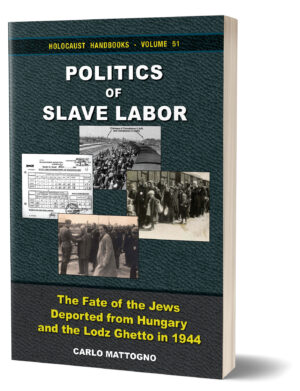Book Announcements
Politics of Slave Labor
The Fate of the Jews Deported from Hungary and the Lodz Ghetto in 1944
Authored by Carlo Mattogno
Carlo Mattogno, Politics of Slave Labor: The Fate of the Jews Deported from Hungary and the Lodz Ghetto in 1944, Castle Hill Publishers, Bargoed, November 2023, 6”×9” paperback, 338 pages, index, bibliography, b&w illustrated, ISBN: 978-1-59148-325-0. This is Volume 51 of our prestigious series Holocaust Handbooks. The eBook version is accessible free of charge at www.HolocaustHandbooks.com. The current edition of this book can be obtained as print and eBook from Armreg Ltd, armreg.co.uk/. The book’s two introductions to the parts on Hungary and Lodz are featured in this issue of Inconvenient History.
Just half a year ago, I made sure that Carlo’s vintage article on the Lodz Ghetto finally finds its well-deserved entry into Inconvenient History, after it had lingered in the CODOH library for years.[1] Little did I know that Carlo had used this very contribution as his launch pad for a more-thorough study that forms Part 2 of the present book. Another vintage article by Carlo on the fate of the Jews deported from Hungary in 1944, published on CODOH in 2001,[2] forms the skeleton of Part 1 of this book, much fleshed out with new insights and additional source material. Shedding light into both topics has far-reaching, if not to say devastating consequences for the orthodox Holocaust narrative.
Ever The deportation of more than 400,000 Jews from Hungary to the Auschwitz-Birkenau Camp from mid-May to early July 1944 is said to have been the pinnacle of this camp’s extermination frenzy. It was allegedly followed in August 1944 by the extermination of more than 70,000 Jews deported from the Łódź Ghetto.
For the present book, the author has gathered from vast archival resources all the evidence available on both events. In painstaking research, the author proves almost on a person-by-person level what the fate was of many of the Jews deported from Hungary or the Łódź Ghetto.
 In the case of the Jews deported from Hungary, it can be demonstrated that those among them who were deemed fit for forced-labor deployment – some 30% of all deported Jews – were indeed sent to forced-labor assignments throughout territories still under German control at that point in time. For the Łódź Ghetto, available documentation shows that almost all of these Jews were merely relocated, together with their production equipment. The challenge was to move them out of harm’s way of the invading Red Army.
In the case of the Jews deported from Hungary, it can be demonstrated that those among them who were deemed fit for forced-labor deployment – some 30% of all deported Jews – were indeed sent to forced-labor assignments throughout territories still under German control at that point in time. For the Łódź Ghetto, available documentation shows that almost all of these Jews were merely relocated, together with their production equipment. The challenge was to move them out of harm’s way of the invading Red Army.
Little documental or reliable anecdotal evidence exists about the fate of those Jews deported from Hungary who were classified as unfit for labor. This concerned mainly children together with their primary caregivers (usually their mothers) as well as the elderly and frail. Testimonies of third-party observers mainly from inside the Auschwitz Camp indicate that these Jews were slaughtered in the alleged homicidal gas chambers.
The claimed magnitude of this slaughter, with ten thousand and more victims every day, is said to have exceeded the Auschwitz crematoria’s capacity. Therefore, the majority of these victims were presumably burned on huge outdoor pyres. However, air photos taken by several reconnaissance missions of Allied air forces refute these claims, showing an entirely peaceful Auschwitz Camp during that time span. Hence, the available evidence points at brutal politics of slave labor rather than mass-murderous genocide.
* * *
Post Scriptum: This book has two sections consisting almost exclusively of quotes from statements by witnesses who had been deported from Hungary or Łódź Ghetto to Auschwitz, and who ended up – not in the gas chambers, but in labor camps all over Germany (Section 1.6., pp. 60-89; Section 2.7, pp. 193-201). Castle Hill’s style definitions automatically render quotations indented and in italics. Hence, the sections mentioned are dominated by text in italics. According to Michael Santomauro, this amounts to torturing our readers, so he threatened to destroy any future Castle Hill book with similar features. If our readers feel tormented by these italics, I sincerely apologize. As compensation, I may indicate that your suffering is incomparably less severe than the torture experienced by orthodox believers reading this book. That thought may give you some pleasure.
Miscellaneous Book

Castle Hill released a new edition of the following older book:
Cyrus Cox, Auschwitz – Forensically Examined, 2nd edition (November 2023)
This book was updated to reflect the most-recent bibliographic information as well as the current situation at censorship front, and a few minor errors were corrected. This handy and concise overview of Auschwitz forensics is still in 5×8 format, though.
Endnotes
[1] See his article “The Ghetto of Lodz in Holocaust Propaganda” in Issue No. 2.
[2] Carlo Mattogno, “The Deportation of Hungarian Jews from May to July 1944: A Preliminary Account,” April 12, 2001; https://codoh.com/library/document/the-deportation-of-hungarian-jews-from-may-to-july-1944/.
Bibliographic information about this document: Inconvenient History, 2023, Vol. 15, No. 4
Other contributors to this document:
Editor’s comments:
